Volleyball exercises for u17
Combination of playing overhand, blocking and defending in teams of 4.
- At the net play 2 times overhead, 1 time for yourself and the next ball to the defense.
- Defense plays ball back underhand. (wide)
- After playing overhand block 2x at the net.
Extension of the exercise:
- Instead of playing the second ball overhead, hit it in a targeted way.
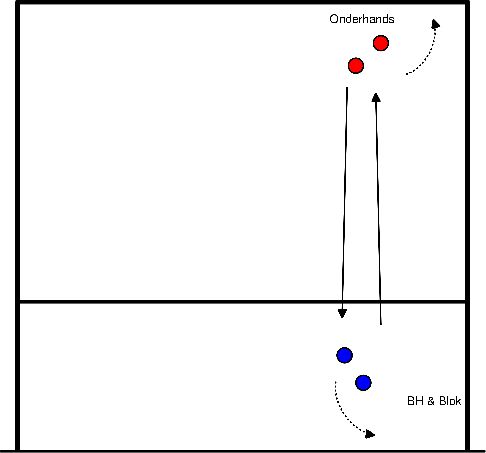
- On one side of the field there is a six in full formation.
- On the other side are 3 players.
- Behind the 3 players stand the servers.
- Exercise:
- Servers serve the ball, the 6 team defends this ball and plays out the rally.
- The 3-man team may defend and also rally.
- Point count:
- Service error, 1 point for the team that was set up.
- Ball on ground by the 3 team, point for the essayed team.
- Good service, but rally won by 3-player, point for 3-player.
- IF 3-TAL has 3 points three move on, if TEAM has 12 points, 3-tal and all servers must push up 5x.
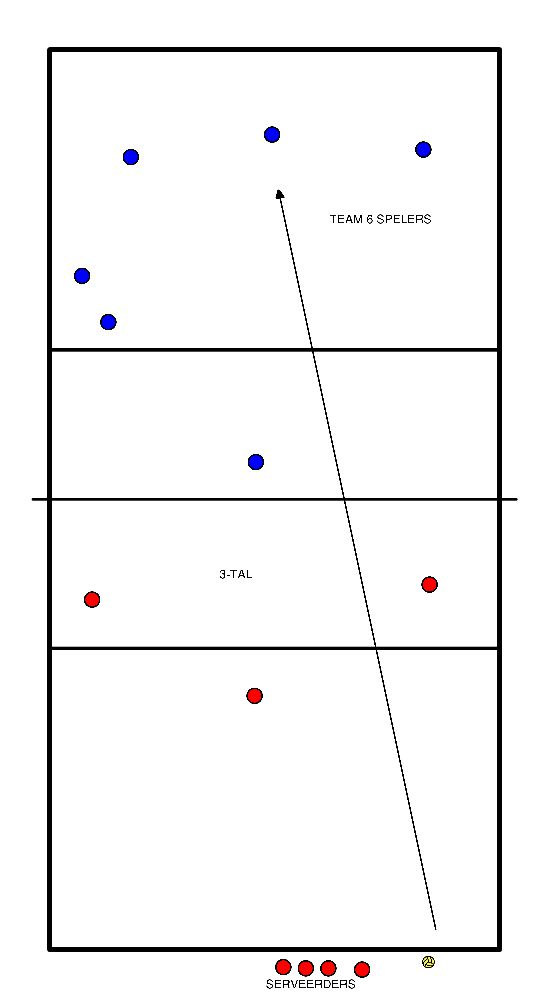
- 5 full laps in run around the field, bouncing left-right.
- Then all on the sideline: (6 -6):
- Ball on the ground, sitting low to halfway around the field and back (10 X).
- Ball on ground, sideways low moving to opposite side, rolling back ball and inciting to dive and arrive at opposite side in front of ball again.
- Ball 2 x BH up and 3rd ball BH forward, etc to opposite side and AW back in the same way.
- Same as OH.
- 2 x 6 before the 3 m line, throw ball over the net into the opposite side's backfield and catch after 1 bounce.
- In 2 pairs:
- In 2 x BH pass over and flat on belly, get back up as soon as possible and continue playing.
- 8 x controlled attacks after which the roles are reversed without stopping.
- Defender with back to attacker when kicking ball on front feet, on signal to turn around to defend (10 x).
- (Defender passes ball back to player at the net, turns around and taps back line, sprints forward and defends ball on 3m-line.
- (Russian passing-drill (1.10 min)
- This exercise can be done in 3 or 4 teams.
- Minimum number of players is 6 and maximum 8 per available field.
- In a 4-player team, two players on each side of the net.
- Use during the exercise half a net width per 3-4 team.
- In a 4-player team:
- 2 players on each side.
- The ball is thrown over the net at the start.
- Player A plays the ball for himself and at the 2nd contact he gives a set-up for player B.
- Player B tips the ball over the net with 1 hand.
- Player C plays the ball for himself and then gives a set-up for player D.
- D tips the ball over the net.
- After a team has played the ball over the net the players change places.
- In the case of a 3-player team:
- 2 players on one side of the net and the other player only on the other side.
- Player C has the ball and throws it over the net to the 2 team.
- Player A plays the ball for himself and at the 2nd contact he gives a set-up for player B.
- Immediately after giving the set-up, player A goes under the net.
- Player B tips the ball over the net with one hand.
- Player C plays the ball for himself and gives a set-up for player A.
- Player C goes to the other side of the net immediately after giving player A a set-up.
- Player A tips the ball over the net to player B.
- Player B plays the ball for himself and gives a set-up for player A.
- After giving the set-up player B goes under the net.
- Expansion:
- Possible mandatory blocking of tip ball by player not doing the passing.
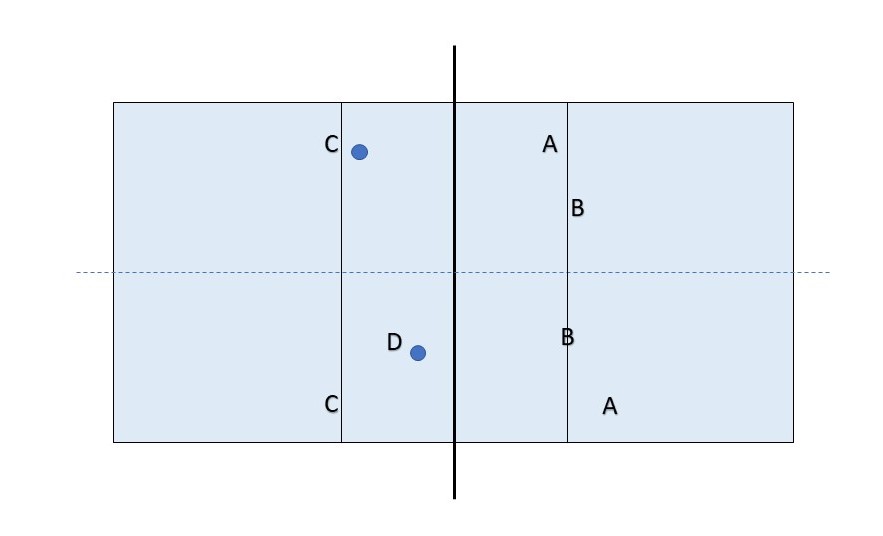
- Possible mandatory blocking of tip ball by player not doing the passing.
- A-side (PL's, 1 slide, 1 libero, 1 SV)
- Service 1 to 2 passers on the other side. (simple deep service, wrong service is 3 x push-ups).
- SP to SV 2.
- PL makes block jump and moves to UGP attack.
- SV 2 set up to #4.
- PL runs on from outside to inside and attacks straight through to #1 where service 1 defends.
- B-side (1 slide, 3 x centre, 1 libero, 1 SV)
- Service 1 to 1 passer across.
- SP to SV 1.
- M / Dia makes block jump and moves to UGP attack.
- SV 1 set up to #3 or #2.
- Good run and attack at #5 where service 2 defends.
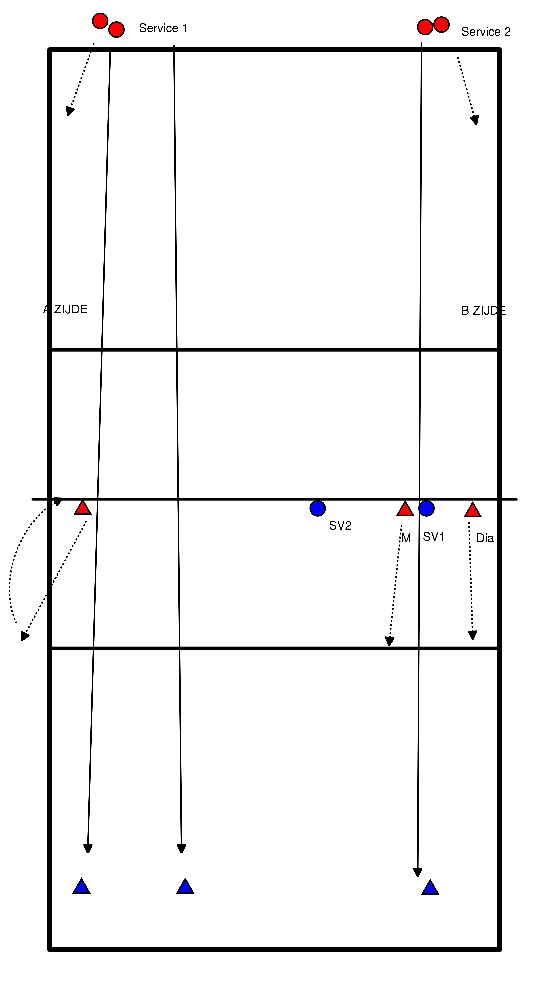
- Organization:
- 2 players with ball at the end of a bench at the net on field B.
- Libero at position 5 on field B.
- 2 players with ball on the backline on field A.
- Trainer with balls at the right side of field A.
- Remaining players at position 5 on field A.
- Implementation:
- 1st player comes running at p4, blocks ball.
- On coming down the player on the back line p6 throws up the ball.
- Blocking player is going to play this ball up and then runs back.
- For a 2nd block to then defend the back line.
- Then trainer throws a ball on the 3m-line to be attacked on L.
- Pick up the ball and give it to the trainer.
- Solving points:
- Do not start too fanatically.
- Regularly change the players on the bench and on the back line.
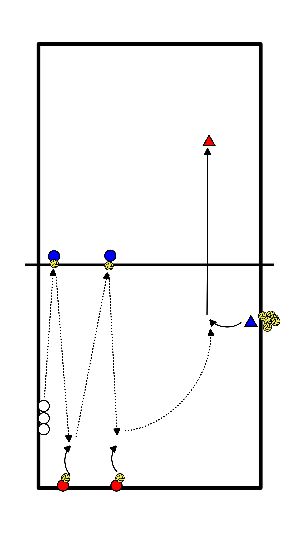
- Organization:
- 2 players on p2 with balls.
- 2 players in the backfield.
- 2 (or more) players out of the field.
- Implementation:
- During 1 minute, the players on the p2 are going to keep the field players busy with attacks, tip balls, etc.
- Let 1 player on p2 work and as soon as a ball is not defended, the 2nd player takes over.
- The players off the field take care of ball safety.
- After 1 minute the players on p2 become defenders, defenders go out of the field and 2 new ones on p2.
- Organization:
- 3 passers including a PL and the Libero on field A.
- Playmaker on field A.
- Serve and block p2 at field B.
- Defenders on field B.
- Execution:
- Change service into pass in setup in attack on p4.
- Change after 3x attacks on p4.
- Expand:
- Add a block p3.
- Swap at 3x score.
- 1 player at the net on position 2/3
- 3 players in the backfield.
- The player at the net puts the defense to work and has the freedom to touch each ball at least once up to a maximum of three times.
- The defense makes sure that the ball reaches the player at the net in 1 or 2 times.
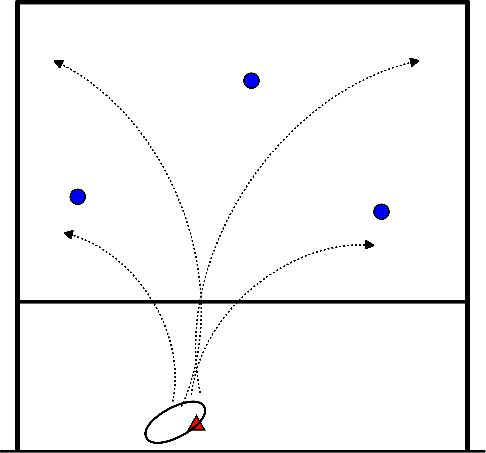
- Objective:
- Increase responsiveness.
- Place one player in the corner of the field.
- Have at least 4 players stand around him in a quarter circle.
- Each player has his own ball.
- Throw the ball in tempo (tight) on the knees of the player in the corner to pass back underhand.
- After passing, immediately throw the ball to the next player in the quarter circle.
- Player in the corner so consecutive balls in underhand pass back:
- Important to stay low.
- Expect the ball.
- Respond regardless.
- About 5 rounds and then replace the player in the corner.
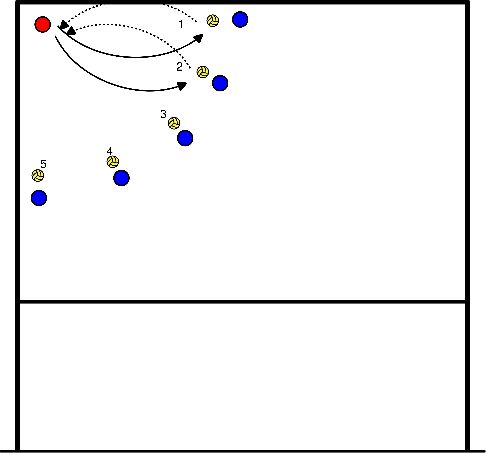
- Two players stand behind each other.
- About half a meter apart, facing the same way.
- Another player stands 3 or 4 meters away from them and has a ball and throws it to upper hand.
- The one who throws throws randomly on player 1 and 2.
- Player 1 or 2 calls loose if he thinks the ball is for him and plays overhand back.
- About 20 balls in a row.
- Then the group of 3 changes position until everyone has been there.
- After that again, but now without talking.
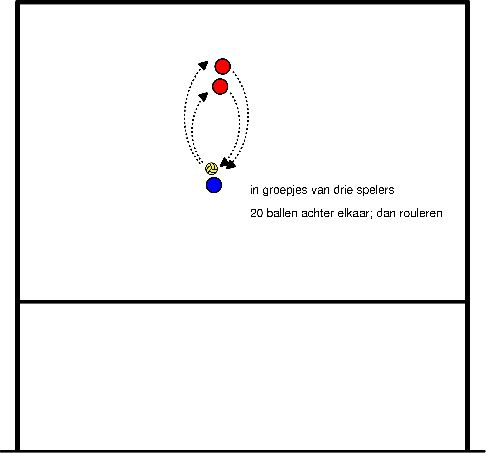
- All on the 3 meter line facing the net.
- If necessary divide in two halves.
- In slow motion synchronise the attacking pass. (right-handed)
- The next steps are in an arc towards the net; by doing this all at once in synchrony, they oblige each other to run in an arc:
- Left small step; take arms to the front; start of forward force
- Right big step; arms all the way back; deep in knees; accelerationof forward force
- Left foot in front of the right (close step), with the foot parallel to the net; forward force is slowed down
- Throw both arms up and push off with 2 feet up; forward force is converted into upward force
- Right arm backwards like baseball/arrow pitcher; left arm points in direction of desired ball path; strike ball and land through knees approx. 0.5m in front of the net








